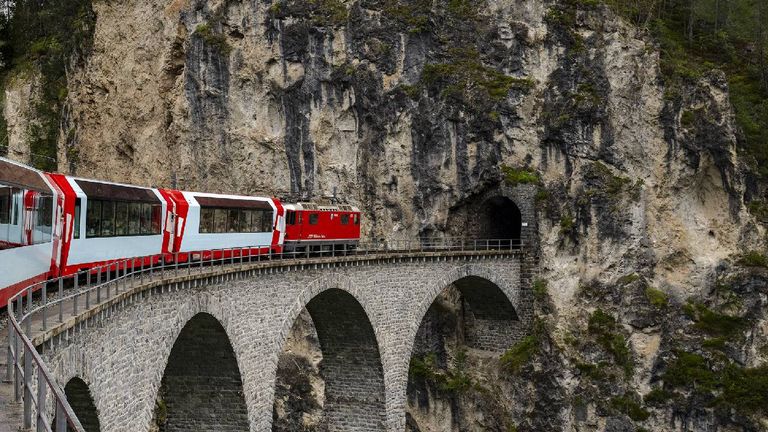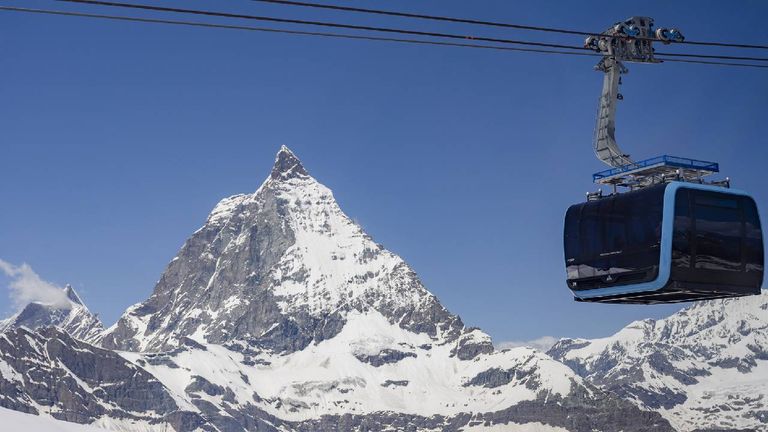Seeing the Matterhorn up-close was a bucket list item for me and my son, Josh, but we were not as excited about traveling on the various mountain railways.
But experiencing Switzerland’s trains quickly became a highlight of our Swiss Trains and Italian Lake District itinerary, thanks to our tour operator, National Geographic Expeditions (NatGeo).
 The NatGeo Expedition to Switzerland and Italy includes traveling on the iconic Glacier Express to St. Moritz.
The NatGeo Expedition to Switzerland and Italy includes traveling on the iconic Glacier Express to St. Moritz.
Credit: 2024 Amy Smith/Disney
While waiting on the platform for the train from Zurich to Zermatt, Tim Jepson, a NatGeo Expert (and British author and journalist), pointed to the Mondaine clock and explained that official Swiss Railways clocks have a unique feature that keeps every station in the rail system synchronized to the second.
Jepson told us to watch as the red second hand stopped for two seconds when it reached 12 p.m., allowing the minute hand to jump to the next minute. And, he explained, every clock in every train station does this.
This small piece of incidental trivia, shared on minute No. 1 of our 10-day trip, set off Josh's quest to purchase a Mondaine watch with the same two-second delay (yes, that’s a thing).
Similarly, following a lecture about the history of the Swiss Army Knife, a noticeably large percentage of our group (me included) immediately headed to the only store open in St. Moritz on a Sunday to purchase knives of our own.
Jepson's superpower of weaving big-picture information about the region’s history, geography, and culture with out-of-the-box fun facts was the key to making the trip work for everyone, which in our group included travelers ages 8 to 80.
He told us the average NatGeo traveler has generally skewed older, but he also noted that the demographic is changing.
“People associate the NatGeo brand with learning, science and curiosity about the world,” he says. “Previously, I expected travelers ages 50 to 85 — with a few outliers — but increasingly, those outliers are becoming more common, so these are trips that work for multiple generations.”
What Travel Advisors Should Know
Nevertheless, he adds, travel advisors may still need to guide clients toward the best NatGeo itinerary, especially for families with younger kids. For example, if clients are animal lovers, they may want to choose trips to Asia, Africa, or the Galapagos Islands.
Advisors can recommend that their history buffs pick itineraries in Egypt, Europe and India. The Switzerland adventure is perfect for train fans, but also hikers. And, of course, NatGeo Family Journeys are specifically designed with kids ages 7-12 in mind.
 A highlight of the Swiss Trains and the Italian Lake District itinerary is seeing the Matterhorn from the Gondolas to Glacier Paradise.
A highlight of the Swiss Trains and the Italian Lake District itinerary is seeing the Matterhorn from the Gondolas to Glacier Paradise.
Credit: 2024 Amy Smith/Disney“What excites me most about NatGeo Expeditions is that they combine the mission of the National Geographic Society with an elevated vacation, so you have a luxury-focused experience that features scientists, storytellers and conservationists,” said Heather Straight, CEO of Key to the World Travel . “It’s a good fit for clients used to luxury who want to travel with purpose, as well as families with older kids — particularly late teens and beyond — who want to see the world together, but are looking for more adventure.”
In addition, clients should know that even though NatGeo Expeditions is part of Disney Signature Experiences, the tours are not “Disney trips,” in the vein of a Disney theme park vacation, cruise or hotel stay. And they are also quite different from Adventures by Disney tours.
“NatGeo Expeditions is connected to the DNA of the National Geographic brand,” said Javier Moreno, senior vice president of Disney Destinations Sales Solutions. “It’s about exploration and protecting the planet, so it offers adventures through a lens that’s different from Adventures by Disney. That's what it makes it unique.”
The National Geographic Difference
Jepson notes that people often choose to travel with NatGeo because they know “they’re going to get something different,” thanks to exclusive opportunities they would never be able to experience on their own.
On our trip that included a lecture from a mountaineering expert at the Matterhorn Museum in Zermatt, who, when asked if he could recommend a book about Matterhorn expeditions, directed us to the three books he has written on the subject.
We also took a pre-hours tour with the curator of the Segantini Museum showcasing painter Giovanni Segantini’s works, plus a private tour and tasting with the owner of family-run Hanselmanns chocolate factory in St. Moritz, a guided tour of the 200-year-old Teatro Sociale opera house in Como (something the guide said nobody gets to do), and a pasta cooking demonstration (and amazing meal) from chef Marco Sala in Varenna . Sala also prepared our private farewell dinner in the gardens of a villa in the town of Mandello del Lario.
 Clients will enjoy a private cooking demonstration and dinner in Varenna.
Clients will enjoy a private cooking demonstration and dinner in Varenna.
Credit: 2024 Amy Smith/DisneyAccess and knowledge are cornerstones of NatGeo Expeditions, and the ability to learn from local experts in each destination —along with the NatGeo expert traveling with us — set the experience apart.
However, NatGeo also knows different travelers have different interests and experiences, so there’s flexibility within the structure of the itinerary for clients who have been to a destination before (or who are not interested in a particular activity) to explore on their own. Of course, NatGeo isn’t only about highbrow education; we also had a fondue dinner in a cheesy (pun intended) Zermatt restaurant.
Another benefit of traveling with NatGeo? As we watched fellow train travelers struggle to roll their luggage over cobblestones in Zermatt and down steep stone steps in Varenna, we were thankful ours were already in our hotel rooms, waiting for us.